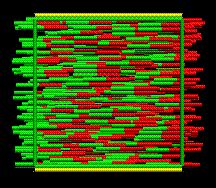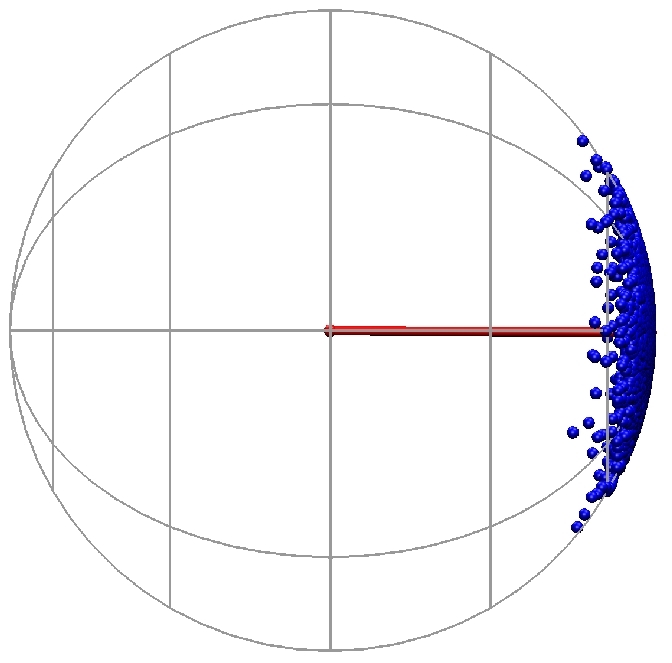|
|

|
 |
 |
 |
 |
 |
 |
 |
 |
 |
 |
 |
 |
 |
Rod-like Colloids

|
Click here
for an explanation in Dutch.
Klik hier
voor uit een uitleg in het Nederlands.
|
Single elongated rigid particles in a shear flow
trace out Jeffery orbits,
named after the scientist who first described this motion.
It is to be expected that
in a dense system the particles will strongly interact
and will not be able
to perform Jeffery motion independently of each other.
If there is any tumbling at all,
this has to be performed by the particles collectively.
In order to study this intriguing motion,
we developed event-driven Brownian dynamics simulations
[ 1,2].
collective tumbling

|
The picture on the left shows
the start configuration of the simulation,
with all rods oriented along the horizontal axis.
For clarity, the ends of the rods are coloured red and green.
A linear shear flow moves the top of the box to the right,
and the bottom of the box to the left,
as indicated by the yellow lines.
Click here (29 MB) or on the picture
to see what happens next.
The actual simulated system contained 1750 rods,
of which only 500 are shown in the movie.
Each rod has an aspect ratio (L/D) of 25,
the volume fraction of rods is 14%.
|
end-to-end vectors
|
The blue dots in the picture on the right
represent the end-to-end vectors of the rods,
scattered over the surface of a sphere.
Drawn in red is the director,
i.e. the experimentally accessible average direction,
which in this frame points along the flow direction.
Click here (13 MB)
or on the picture
to watch the time evolution of the system.
Since some rods are left behind during the tumbling,
a diametrically opposed secondary cloud develops over several revolutions.
This effect is also observable in the preceding movie.
|

|
director motion vs mesogen motion
Closer inspection of the simulations reveals that
the rods and director do not tumble in the plane of the pictures
but follow paths akin to that of paddles during kayaking.
Our calculated tumbling periods for the director are in good agreement with
recent experiments on sheared solutions of rod-like fd viruses.
[1,3].
At high shear rates
the director starts wagging up and down around the shear direction,
accompanied by negative first and normal stress differences
[4],
and at even higher shear rates
the director flow aligns along the shear direction,
all in agreement with experiments.
The simulations reveal, however,
that the rods are always kayaking
-- a reduced coherence at higher shear rates
makes it impossible for the director
to follow this motion faithfully
[5].
|
 |
 |
 |
 |
 |
 |
 |
 |
 |
 |
 |
 |
 |
selected publications
|
1
|
Kayaking and wagging of rods in shear flow
Y. Tao, W.K. den Otter and W.J. Briels
Phys. Rev. Lett. 95, 237802 (2005)
|
|
2
|
Isotropic-nematic spinodals of rigid long thin rodlike colloids
by event-driven Brownian dynamics simulations
Y.G. Tao, W.K. den Otter, J.K.G. Dhont and W.J. Briels
J. Chem. Phys. 124, 134906 (2006)
|
|
3
|
Periodic orientational motions of rigid liquid-crystalline polymers
in shear flow
Y.G. Tao, W.K. den Otter and W.J. Briels
J. Chem. Phys. 124, 204902 (2006)
|
|
4
|
Shear viscosities and normal stress differences
of rigid liquid-crystalline polymers
Y.G. Tao, W.K. den Otter and W.J. Briels
Macromolecules 39, 5939 (2006)
|
|
5
|
 Kayaking and wagging of liquid crystals under shear:
comparing director and mesogen motions
Kayaking and wagging of liquid crystals under shear:
comparing director and mesogen motions
Y.G. Tao, W.K. den Otter and W.J. Briels
Europhys. Lett. 86, 56005 (2009)
|
|
 |
 |
 |
 |
 |
 |
|
 |
 |
 |
 |
 |
 |
|


